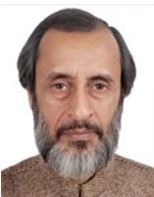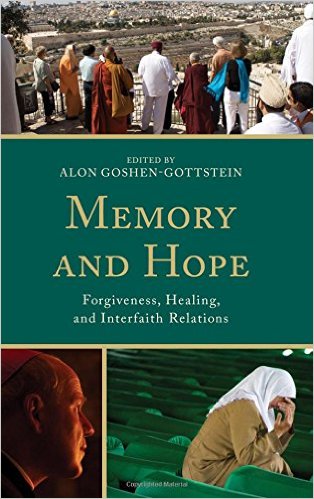Memory and Hope: Forgiveness, Healing, and Interfaith Relations

Memory and Hope: Forgiveness, Healing, and Interfaith Relations
We are proud to announce that the fourth volume of the Interreligious Reflections series, “Memory and Hope: Forgiveness, Healing, and Interfaith Relations,” published by Lexington Press is now available. If you would like to purchase your copy at a special discounted price, please click on the image below.
(All volumes in the series are available at a reduced rate. In the United States use code LEX30AUTH15, in the UK and worldwide use code 4M15DOTSON when ordering)
In May, 2014, members of the Elijah Board of World Religious Leaders gathered at St Ottiliens Monastery just outside Munich to discuss the question of Memory and Hope. The subject of historical memories as a barrier to good interreligious relations had arisen frequently over the years of Elijah’s work. As Alon Goshen-Gottstein says in the foreword, “Memory is an asset, in that it recalls what is most important in our spiritual life, but in some contexts it is also a burden, or a problem, or a challenge one must contend with, precisely as one seeks to advance towards the goals of a religious tradition. Our religious traditions are complex entities. They include the highest spiritual and moral teachings; they are also the reservoirs of the memories and imprints of the entire range of human realities that religions, as social realities, have manifested in their histories. This includes, among other things, the history of tension between competing religious groups, the imprint of trauma inflicted in the name of religion and the recollection of the various ways in which religion and violence have been related to one another throughout human religious history.”
This volume proposes that within each of our religious traditions are the teachings and the tools to “purify” negative memories of the religious other and to transform them into vessels of hope.
To read a summary of the contribution of our authors from six different traditions, read on:
Meir Sendor

Meir Sendor’s chapter “The Malleability of Collective Memory in Jewish Tradition” makes clear to the reader even in the choice of title that memory is not fixed, nor is it factual in a fundamental positivist sense. The word “tradition” suggests dynamism and the possibility of interpretation. Jewish collective memory addresses painful memories and Jewish history is narrated primarily as a history of oppression. Victimhood fuels hostility. Given the centrality of memory in Jewish consciousness, and especially memory of suffering and victimhood ritualized in prayer and key festivals, Sendor grapples with the challenge of developing a theory of memory that does not keep a Jewish mentality fixed in a mental space of victimhood and isolation.
Sendor focuses his efforts on the dynamics of balancing memory and of balancing remembering and forgetting. Adjustment of religious collective memory involves authority, and requires addressing the authority of scripture or tradition, that has carried forth memory up to the present. Authority must balance authority and alternative religious authority from within tradition must be found in order to temper the negative impact of painful memories.
If memory is selective, we have the possibility of revisiting it with a view to establishing a new equilibrium. The archetypal subjugation in Egypt is a case in point. Scripture, festivals and liturgy all impress upon us the memory of our subjugation in Egypt and ensuing liberation. However, the Torah’s view of the Egyptians is not exclusively as oppressors, but also as those who gave hospitality to Israel in the first place. Amalek, Israel’s biblical arch-enemy whose evil deeds we are commanded to remember, can be redeemed in some way, as we note in later tradition. The rabbis teach us that the grandchildren of Haman, of Amalekite descent, became converts and Torah scholars. Sendor’s work opens us up to the possibility of memory operating in multiple dimensions. It operates in history but it also operates in the spiritual domain, bringing to light essential principles that shape memory in the present.
Biblical prophecies that downplay the memory of the past in light of what might be called a future memory allow us to contextualize and relativize the burden of past memory. In this way hope addresses memory. However, the significance of eschatological memory is only inasmuch as it is lived in the present, which brings us back to Sendor’s core strategy – confronting past memory with the present moment. He suggests that it is repentance which allows us to transform the painful memory of the past into a more harmonious present. Hope lies in our recognition that we are never locked up in the memory of the past and the roles it casts us in.
Flora Keshgegian

Flora Keshgegian’s “Memory and Hope in Christianity” approaches the subject from a different methodological and ideological perspective. Her paper shares the assumption that memory is never fixed but something subject to transitions. This is why Keshgegian prefers to speak of “remembering”, rather than memory. Memory is always constituted in the present. Instability and change are fundamental to the process of remembering. That remembering is an active process means there is no neutral or objective remembering. What is remembered is intrinsically related to the dynamics of the remembering community, and these in turn open up to political dimensions and perspectives of power.
Remembering provides Keshgegian with the opportunity to tell – to remember – the entire Christian story, from the very vantage point of memory and its relationship to shifting power dynamics. Recognition that for most of its history the Church has been associated with empire is crucial to a recognition that the Church’s memory is largely that of the conqueror, the colonialist, the one who has power and who applies that power at the expense of others. In the process, other voices have been written out of history. This includes voices of forms of Christianity that did not conform to a “proper” theological or metaphysical view, as well as voices of various religious traditions that were taken over by conquering Christianity.
The work of purifying and retrieving memory is very particular in the case of Christianity. Keshgegian brings the awareness that in considering dynamics of memory and their transitions, we cannot divorce these from issues of power and empowerment. Accordingly, the problem of dealing with painful memories will look very different from the side of the powerful or the disempowered, the conqueror and the conquered, and ultimately – from the side of the victim or the perpetrator. Keshgegian points to ritual as the domain that will allow us to address painful memory, traumatic memory. The rituals she recommends are not the conventional rituals of forgiveness, that place the burden on the victim. New rituals need to be developed. The practice of lament, an ancient biblical practice, is suggested as one possibility. Lament allows one to name suffering, to cry out in anguish, even to express anger, without being forced into forgiveness. At the same time, the perpetrator, especially the institutional perpetrator, has to deeply own the violence committed. Mourning and acknowledgment lead to a process. They allow the pain and trauma to be held. Such holding opens up to the power of life and moving on. Herein lies hope. Hope is not the ultimate historical vindication described by the theologians she discusses. Rather, for Keshgegian hope consists in the capacity to resume life despite trauma.
Anantanand Rambachan

Anantand Rambachan’s “Hope is Greater than Memory” provides a Hindu perspective. Memory has a crucial role in Hinduism and many of its key practices hinge on memory. This includes recitation of scripture, personal piety revolving around chanting of a personalized mantra, a constant memorial of divine presence, the celebration of festivals and more. Rambachan suggests that various practices of memorialization are centered around one core principal – recognizing our indebtedness to others and cultivating gratitude and generosity to share with others. Memory also provides the deep logic for the spiritual quest itself. Memory of the Self and the lost truth of its unity with the Divine is the purpose of spiritual practice and the key to spiritual liberation. In this sense, then, the entire spiritual life, ranging from practices to the ultimate purpose of the spiritual life, may be presented in terms of memory.
This suggests that memory is at the heart of the battle for spiritual evolution. Whereas for other traditions it is group memory of the enemy or of painful historical moments that has to be overcome for the sake of peace, reconciliation and group relations, in the case of Hinduism discourse begins with the individual and memory relates to subtle examinations of how the individual is metaphysically positioned. Memory lies at the root of one of the most fundamental spiritual challenges – going beyond likes and dislikes, and the negative attitudes, such as possessiveness, anger or jealousy, that they generate. Memory of things we like and dislike is at the source of loss of identity. The quest for ultimate identity, the identity of the Self and its union with the divine, informs the spiritual life.
Memory requires purification. Wisdom is the means of purification. Wisdom involves true cognition of reality. It provides a framework that allows us to loosen the grip of memory upon us, and in some cases even to liberate ourselves from it completely. The core of wisdom is recognition of a unitive view of life, affirming our unity with the divine and the ultimate unity of all. If one can see all as one, and see the Self in all, the negative qualities that are the outcome of negative memories are overcome. If one recognizes ignorance as the root cause of all problems, rather than malice and intentionality, then a compassionate and understanding view ensues, that helps us rise above the attitudes born of ignorance and attachment. This world-view is grounded in a view of the individual in relation to God. It also provides the foundations for a view of society and for solving social issues. Rambachan makes the conscious effort of extending the teachings of the tradition concerning the individual to the realm of inter-group relations. The same factors that govern personal relations – the attitude generated will be mirrored back, the need for practice of compassion and a variety of other lessons that grow from this spiritual view, are relevant also to how one relates to larger social units. The very message of the religious vision offered by Rambachan is one of hope – hope of liberation, of going beyond the negative imprint of harmful memories, of increasing wisdom, of growing reconciliation and social harmony.
Rahuldeep Singh Gill

Rahuldeep Singh Gill’s “Memory as Benevolence: Toward a Sikh Ethic of Liberation” proposes that memory operates on two planes or in two dimensions. This dual function of memory addresses two complementary dimensions of the religious life. One dimension concerns the memory of the community and its history. Memory has a role in constructing identity and it is particularly painful memory, the memory of martyrdom and persecutions that helps a group solidify its memory. A second dimension of memory touches upon the recollection of fundamental truths of spiritual reality. Two aspects are noted here. The first is the memory of death, which conditions our awareness of life. The second is our memory of God, which is the focus of spiritual intention and of practice.
The two aspects of memory point to two dimensions of our identity – a more limited particularistic view and a broader universal view. The two must be integrated and harmonized. The means for their harmonization is ultimately God Himself, Who chooses a community for a purpose. The purpose of the Sikh community is understood through service, where it becomes an instrument for divine caring. The same structure may be considered not only in terms of caring but also in terms of Justice. One form of caring is to seek justice. Seeking justice may be thought of as a means of legitimating or affirming a particular history. But seen from the higher divine perspective, seeking justice is a form of caring for all, for the perpetrator as well as for the victim. Justice is a concrete expression of caring.
Gill suggests that service is ultimately a means of purifying memory. Going beyond the memory of one’s wounds and persecution is made possible by service. This method is more than catharsis or channeling one’s negative emotions to a good end. It relies on a broader view of service as grounded in divine caring, and on the sharing of memory that brings humans and the divine into alignment. Therefore, in service we rise above all that is limited in our particularity, including our pain, and review the source of our pain from the perspective of the divine. Service, then, is the ultimate form of simran, remembrance of the Divine. Herein lies hope as well. What keeps hope out of our horizons is the narrow perspective that we see through when we see only our own limited reality, nourished as it is by the pains inflicted by others. Hope is liberation. As Gill demonstrates, memory of God is a means of liberation. Carrying this core insight of Guru Nanak further, Gill suggests that not only the memory of God, but sharing in how God remembers us is also a means of hope and breaking past the confines of narrow memory. When our horizons open, in caring, in service, in the quest for justice, to God’s own view of reality, and as we are united to God and attuned to His being through higher spiritual memory, we are liberated from the pains of the past, and find hope in the one eternal reality and in its caring expressions towards humanity.
Muhammad Suheyl Umar

Muhammad Suheyl Umar’s chapter from the Islamic perspective, “Repairing Memories – Two Case Studies,” tackles the problems of memory and hope by reversing the order of discussion. Rather than laying the emphasis on theory and seeking to illustrate it with a case study (as other authors in the volume do), Umar examines in depth two case studies, and reflects on the principles that inform these case studies. The problem tackled by Umar is the problem of corrupted memory. Changed memory can be the source of religiously motivated violence. Facing the challenge of altered memory, Umar suggests there is a way of retrieving lost memory. Such retrieval can function as a means for reducing religious violence. Recalling historical truth, despite contemporary political pressures, enables the retrieval of lost memory and can lead to significant attitudinal changes between members of diverse religious communities.
The quest for correct memory is itself a religious quest. It is founded upon a spiritual vision and an eschatological perspective, wherein truth will ultimately reign, and that truth includes how we shall be judged for our own truthful practice. Retrieval of corrupted memory involves two stages. On the technical or outward level, it requires mastery of tradition and a constructive dialogue with it, in which forgotten sources are brought to light and a process of interpretation or reinterpretation takes place. This is the process of ijtihad. However, in order to apply such principles, there must be spiritual motivation. It is only when higher spiritual memory encounters concrete historical memory that such motivation is fully present. Higher memory is memory of God Himself, leading to reintegration of the soul in the divine, with peace as its fruit.
Umar ties together the two conceptual strands of our project – higher memory and historical memory and the critique of memory and its changes through time. His presentation supposes that the former issue provides the motivation and the religious framework within which the latter issue can be worked out. With this theoretical framework in place, we are equipped to appreciate Umar’s presentation of two case studies, where he describes work that has taken place along these lines. One relates to internal Muslim relations, the other to Jewish-Muslim relations.
The work of retrieval of correct memory is ultimately a process of finding balance between conflicting realities. The balancing of conflicting realities ultimately relies on balancing the human perspective with the divine. Only with the recollection of higher truths, mystical, spiritual and eschatological, do we gain the needed perspective for revisiting statements of a historical nature, especially as these concern inter-group relations. From this higher vantage point, a harmonizing or balancing vision can be found that recognizes multiple and conflicting claims and finds truth or validity in multiple perspectives. It offers a vision of ultimate peace, grounded in the higher spiritual peace, translated into the traditional mechanisms that allow a shifting of perspective in concrete historical relationships.
Michael von Brueck

The final essay in the volume is Michael von Brueck and Maria Reis Habito’s “Memory in Buddhism.” The first part of the chapter offers theoretical reflections on memory. Here the role of memory in constructing identities is stated most clearly. This function is true for both individuals and collectives. The identity-constructing function of memory is closely related to memory’s dynamism. Memory seems fixed, but in fact it is not. It is ever changing. The authors present a particular Buddhist sensibility of the impermanence and transience of all things. If all things are refracted through memory, then memory itself is a mirror of their impermanence.
This impermanence, however, is encountered, paradoxically, through moments of illusory fixity, required for the sake of stability of identity. Therefore, there is something inherently paradoxical about memory that delivers to us stability and transience, folded into one complicated moment.
Buddhism may be seen as in some way organized around dealing with memory. As a method of teaching, it requires stability of tradition, practice, ritual. It locates itself in the past, and carries forth a tradition – itself a time related construct – all of which requires faithful memorizing. But there is something fundamentally subversive about the Buddhist approach. All that is constructed in terms of stability of identity and religious institutions is, in fact, only the ground laid for undermining this very stability. A dynamic of constructing and destroying, forming identity and transcending it, characterizes the Buddhist approach to memory.
Von Brueck and Reis Habito’s presentation teaches us that memory and hope should be understood in broader terms than along the axis of time. By memory we refer not only to the recall of past events. Memory includes all things in relation to which we can apply processes of memorialization. Memorialization here is bringing to awareness, making present, cultivating mindfulness. Thus all that is recalled, taken in, integrated, by way of religious teaching, made present to our consciousness, is here treated as a form of memory. Memory, understood so broadly, is in fact a process of making present. Making something present to our awareness allows us to transcend the boundaries of identity that are ego-related and that require going beyond. Zen tradition is an elaborate tradition that celebrates its authenticity by appeal to a chain of tradition, yet its core teaching cultivates an attitude of going beyond past and memory into an experience, grounded in the present. The past is viewed as limiting, the present as fully open. While memory provides psychological and social stability, the present must not be limited by the view of the past, but be open to an appreciation of its open ended perspectives, far broader than the constraints of the past. Wisdom is, for all of us, the key to liberation from memory.

